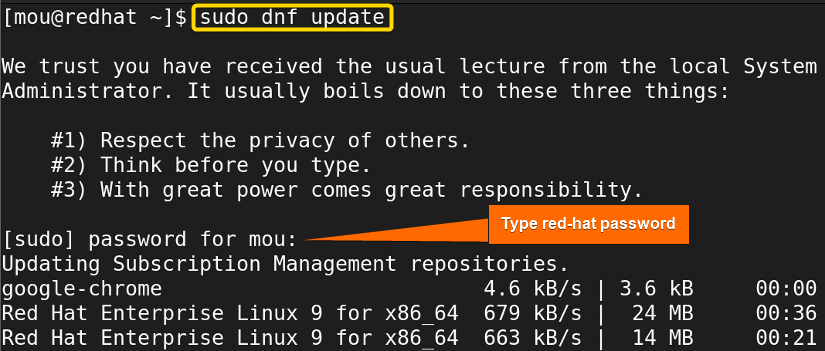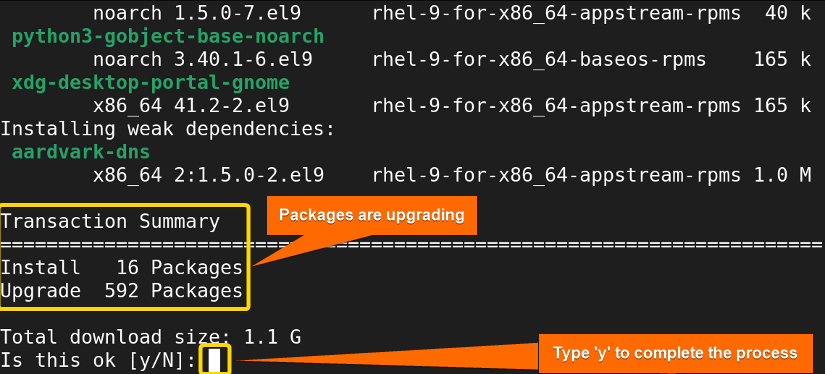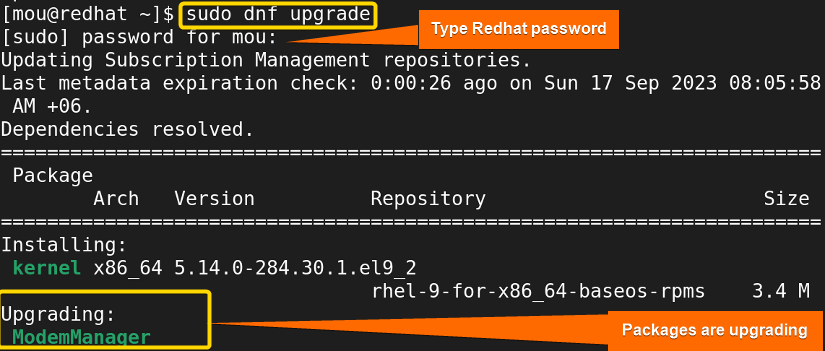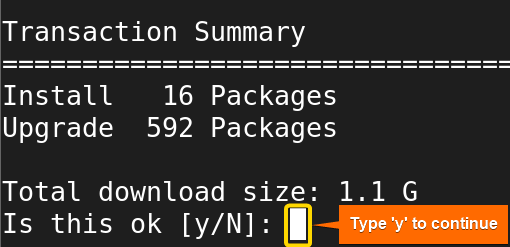FUNDAMENTALS A Complete Guide for Beginners

dnf refers to the Dandified Yum which is an updated version of the yum package manager. This front-end package manager is used widely in Red-hat-based Linux distros such as Red-hat Linux, CentOS, Fedora, etc. With the dnf update, the packages can be updated to their latest versions available in the repository. Moreover, the dnf upgrade command not only updates the installed packages but also removes or replaces the old version by resolving dependency conflicts. To know more about dnf update vs upgrade, keep reading this article.
What Is DNF?
dnf is the next-generation version of the Yum package manager used in Red-hat Linux derivatives. This popular package manager handles package operations such as install, uninstall, update, upgrade, and so on. It has an enhanced dependency resolution algorithm which offers better performance to resolve dependency conflicts. Moreover, it will save your disk space as it occupies less memory to synchronize the metadata of the packages. Automatic bug-fixing capacity also takes this package manager to another level.
What Does “dnf update” Do?
dnf update checks the repositories containing the modern versions of software packages. It compares the version number of the packages stored in the repository with the installed packages. The main tasks of the dnf update command are as follows:
- Updates Packages: When you run the dnf update command, it will download the updates and install them on your Linux system keeping all the dependency and configuration files intact. Moreover, it ensures that you have all the modern features available to fix bugs and you have more secure packages by updating the package lists.
- Resolves Dependencies: It is a great dependency resolver. While updating, many dependency conflicts may occur. However, the dnf update command solves all the issues by removing or installing dependencies on your Linux system.
- Removes No Packages: While updating packages, it will not remove any packages from your system. It does not create any unwanted problems and ensures that it updates only the existing packages.
What Does “dnf upgrade” Do?
This command is used to do a similar task as the dnf update does but it is more aggressive in nature. It updates packages to their latest version available in the repository. Sometimes, the OS system can be broken due to its aggressive behavior. To resolve dependency issues, it deletes the obsolete packages to install a newer one. Be cautious before using this command.
- Installs and Updates Packages: This command installs the new version packages and updates them by replacing the old ones. Also, it gives better security and updates by removing unnecessary packages.
- Resolves Dependencies: Dependency resolution is one of the most efficient tasks done by this command. It can install required dependencies like dnf update. Since upgrading the existing package list is mandatory before the upgrade operation, it installs the dnf update and updates the packages.
- Removes Packages: It can remove any obsolete package if the package is no longer required. Additionally, it can replace the existing packages. In this case, it shows different characteristics than dnf update.
“dnf update” Vs “dnf upgrade”
There are some significant differences between dnf update vs upgrade. Go through this section to know them:
| dnf update | dnf upgrade |
|---|---|
| This command is used to update installed packages. | dnf upgrade is used to upgrade installed packages. |
| During an upgrade, it doesn’t remove older version packages. | Ability to remove the older version package while upgrading. |
| It doesn’t alter package dependency. | Package dependency can be altered with this command. |
| dnf update command does not break the system. | This command may break the system sometimes. |
| Less powerful than the dnf upgrade. | More powerful than the update command. |
How Does “dnf update” Work?
This command is used to update the packages in the Red-hat-based Linux distro. It has a modern codebase that can fix all the unwanted issues. Let’s know the process of updating packages.
- Open the Red-hat terminal.
- Write the following command to update the package version:
sudo dnf updateEXPLANATION- sudo: Provides administrative privileges.
- dnf: Advanced version of yum package manager, used to manage packages in Red-hat-based Linux.
- update: Updates packages to their recent version.
The old packages will be upgraded to the latest versions available after running this command.
Now, type ‘y’ and press ENTER to complete the upgrading process.
How Does “dnf upgrade” Work?
dnf upgrade basically upgrade packages by removing or replacing the existing packages. Here, I will explain the step-by-step process of this operation. Check the steps below:
- Open the Red-hat terminal.
- Write this command to upgrade the package version using dnf upgrade:
sudo dnf upgradeEXPLANATION- upgrade: Upgrades installed packages by replacing or removing the old ones.
After that, type ‘y’ to the prompt and press ENTER to continue the procedure.
The packages will be upgraded as soon as you type y.
Choosing Between “dnf update” and “dnf upgrade”
If you are asked to choose one between these two commands, you can pick the dnf update command to update the installed packages to their newer versions. As dnf upgrade shows quite harsh behavior during the upgrade process like removing the existing packages or dependencies. In this case, to avoid any unwanted errors choosing dnf update is the best option I think. Otherwise, for upgrading packages by removing the unnecessary ones, or if you can take this much risk, you can go for the dnf upgrade command.
Comparative Analysis of “dnf update” and “dnf upgrade”
The benefits and drawbacks of using dnf update and upgrade are listed below:
| Commands | Pros | Cons |
|---|---|---|
| DNF update |
|
|
| DNF upgrade |
|
|
I hope this table assists you in finding the best command according to your preferences. Hear me out if you are confused as they do almost similar tasks. If you don’t want to take a risk, choose dnf update command. Otherwise, go for dnf upgrade to upgrade a package ignoring all the dependency conflicts completely.
Conclusion
Here, I have explored two different commands of Red-hat-based derivatives such as red-hat Linux. Each command has some conditions and risks to apply for upgrading packages. Additionally, I have cleared the confusion of which one is better by presenting the pros and cons and a detailed analysis of each command. Read every step carefully to avoid any unwanted occurrences.
People Also Ask
How do I check for dnf updates?
To check for updates using DNF on a Linux system, you can use the following command: dnf check-update. This command will query the configured repositories and display a list of available updates for the installed packages on your system.
Is DNF better than apt?
DNF and apt are both good package managers, but they have different advantages. DNF is better suited for Fedora, CentOS and RHEL, as it offers better performance and a more intuitive interface. apt, on the other hand, is better suited for Debian-based systems such as Ubuntu, as it is known for its ease of use and strong dependency management. The answer to this question often depends on the type of Linux distribution you are using and your personal preference.
What is the benefit of DNF?
DNF offers improved performance and dependency resolution compared to Yum, making package management faster and more efficient on Linux systems like Fedora and CentOS.
Related Articles
- How to Upgrade With ‘sudo apt-get’ Command [2 cases]
- Yum Update Vs Upgrade [Basic Differences]
- How to Use ‘sudo apt full-upgrade’ in Linux [A complete Guide]
- Apt-get Update Vs Upgrade [What’s the Difference]
<< Go Back to Upgrade Package in Linux | Package Management in Linux | Learn Linux Basics








the manual says `dnf update` is an alias to `dnf upgrade`.
So they are exactly the same.
“`
$ dnf update –help
usage: dnf upgrade
…
$ dnf upgrade –help
usage: dnf upgrade
…
“`
Thanks for the response nonono. Though dnf update and dnf upgrade serve the same purpose, there are some differences. Dnf upgrade may remove the older version packages while upgrading. It is actually more powerful command than the dnf update.